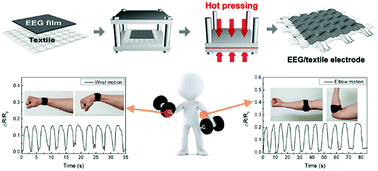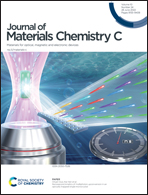Fabrication of highly conductive graphene/textile hybrid electrodes via hot pressing and their application as piezoresistive pressure sensors†
Abstract
Textiles represent an ideal platform for next-generation electronic devices owing to their flexibility, stretchability, wearability, and biocompatibility. Herein, we present highly conductive and flexible electrodes based on electrochemically exfoliated graphene (EEG) and cotton textile; these electrodes are fabricated via hot pressing to be used as sensing materials in piezoresistive-type pressure sensors. The sheet resistance and microstructure of the electrodes can be controlled by varying the surface density of the EEG on the textile substrate. The optimized EEG/textile electrodes exhibited a minimum sheet resistance (Rs) of 1.3 Ω sq−1 as well as high flexibility and durability during a 1000-cycle bending test. The pressure sensors were fabricated by assembling two EEG/textile electrodes, with each electrode acting as a pressure-sensing material; the sensors exhibited a maximum pressure sensitivity of ∼0.16 kPa−1, a wide range of linear sensitivity (up to 100 kPa), a fast response of ∼373 ms, and reproducible performance over 10 000 cycles of pressure loading and unloading. These sensors also functioned effectively as bending-motion, wrist-pulse, and step-motion sensors, as well as on/off-type pressure sensors. Hence, the developed EEG/textile electrodes have the potential to be used in textile electronics and next-generation wearable devices.



 Please wait while we load your content...
Please wait while we load your content...